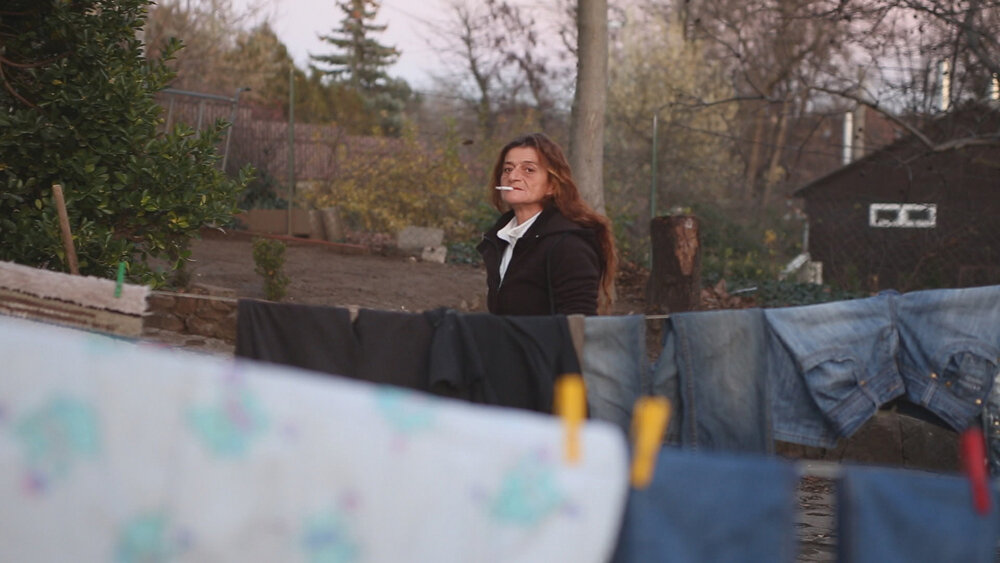A Woman Captured
Originally published without a star rating in 4:3 (13 August 2018).
A Woman Captured (Bernadett Tuza-Ritter, 2017)
★★★
The opening shot of A Woman Captured — which features a woman sleeping then being woken — doesn’t establish any vital character or narrative details but reveals a lot about the relationship between filmmaker Bernadett Tuza-Ritter and her documentary subject Marish, a 52-year-old woman who is a modern-day slave. Tuza-Ritter has been given unusually close access to Marish’s life, filming her sleeping from only a few feet away inside the house where she’s been kept in servitude for eleven years. When Marish’s alarm clock fails to stir her from her sleep, it’s the filmmaker who gently whispers her name to wake her up. Marish acknowledges the camera with a smile, and shows little sign of self-consciousness as she slowly gets up to begin her laborious day. “I feel like I haven’t even slept”, she sighs.
It’s an intimacy which is kept well out of sight from Marish’s “employers”, an unnamed middle-class Hungarian family headed by Eta, the matriarch who snarls orders, threats and abuse at every opportunity (“Marish”, we later learn, is not her real name but a nickname assigned to her by Eta). Marish scuttles around the house responding to Eta’s demands – cook, clean, do this, do that – and is compensated for her work with only a couch to sleep on, inadequate meals, and a supply of cigarettes (which Marish mechanically makes herself using a tobacco roller, as if in an assembly line). Marish also works a twelve-hour shift at a factory but her wages are confiscated by Eta, presumably to pay off some sort of dubious debt. A Woman Captured depicts a world creepily stuck in a time warp, where the existence of slavery is barely disguised, and where there’s a stunning lack of awareness of the possible consequences of being filmed: as a title card informs us, Eta was happy to be paid to allow Tuza-Ritter to film in her home, with little regard for what may become of the footage.
When she’s working in the house, Marish is followed around by a mobile handheld camera which frames out or blurs much of her surroundings to claustrophobic effect (calling to mind Son of Saul, by fellow Hungarian filmmaker László Nemes). The closeness of these shots is a matter of necessity as much as it is style: it’s revealed that Tuza-Ritter was able to film in Eta’s home under the condition that her face, and those of her family, were not shown. As such, Eta is relegated to a sinister offscreen presence, with only glimpses of her hands and long red fingernails hinting at her appearance. The tight framing is relaxed somewhat when Marish is shown alone in her sleeping quarters or outside the house; it’s during these moments that Tuza-Ritter is heard from behind the camera, speaking intimately (and secretly, for Eta has forbidden her to film Marish alone) with her subject about her life and predicament. A Woman Captured shifts between these two approaches: a conventionally hands-off, observational account of a woman’s unpaid labour and confinement, interspersed with a series of filmed interactions between filmmaker and subject. It’s in the latter where the filmmaker becomes a character and participant in her own right, and through which her roles and ethical responsibilities come to the fore.
Like many observational documentaries, A Woman Captured is structured like a fiction film because it makes for efficient and entertaining storytelling; here, Tuza-Ritter also indulges in the trappings of a thriller film. There’s the narrative, which progresses from captivity to freedom and hinges on a climactic escape sequence set at night; a villain, whom we can hear but not see, and who seems all the more villainous because of it; a conspiracy, in Marish and Tuza-Ritter’s clandestine relationship; and a visual style which works in tandem with the film’s narrative progression, opening up as Marish escapes and her world expands. But Tuza-Ritter often strains too hard to meet the demands of these generic trappings. The film sometimes feels overedited, sacrificing reality for narrative economy, and it’s plainly obvious that the actual escape was far more straightforward than is depicted: fast cuts abound, propelled by shaky and hyperbolic camerawork, as well as an overbearing score. And because important details are left vague – we never quite learn the precise circumstances of Marish’s captivity, or what dangers she’d face should she decide simply to pack up and leave – it’s difficult to determine what exactly is at stake.
The effectiveness of the film depends on our willingness to put aside such questions, and how much faith we place in the filmmaker not just to watch but to watch over her vulnerable subject. Aware of the ethical quandaries posed by her involvement and eager to at least attempt to address them, Tuza-Ritter exposes her own reservations about the filmmaking process in her discussions with Marish (“You’re not angry at me for paying them?”; “You don’t mind me shooting while you’re being mistreated?”; “You really think I will abandon you?”). Marish is generally very supportive, but her own doubts about the filmmaker as saviour are also duly included, telling Tuza-Ritter that she believes she’ll eventually be betrayed by her (“Your intuition stinks”, the director assures her and the audience).
Even with these moments and the inclusion of contextualising title cards, questions linger about Tuza-Ritter’s methods and her capacity to help Marish over the film’s year-and-a-half production period. In the end, it might be necessary to defer to Marish’s own modest words to help ease these concerns and judge the film’s merits, at least in part: “If you manage to screen [the film] just once, a few people might realise how people shouldn’t be treating one another.” Despite the troubled navigation of its own approach and ethics, as a documentation of human exploitation in a time and place where many won’t expect to find it, A Woman Captured is illuminating viewing.

